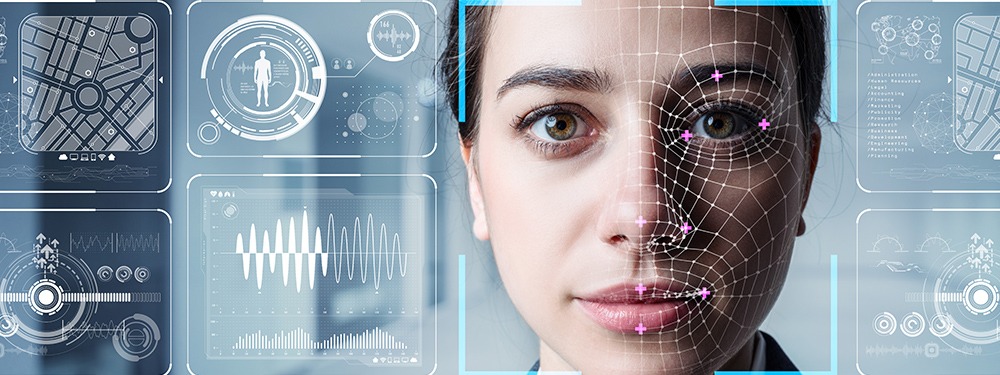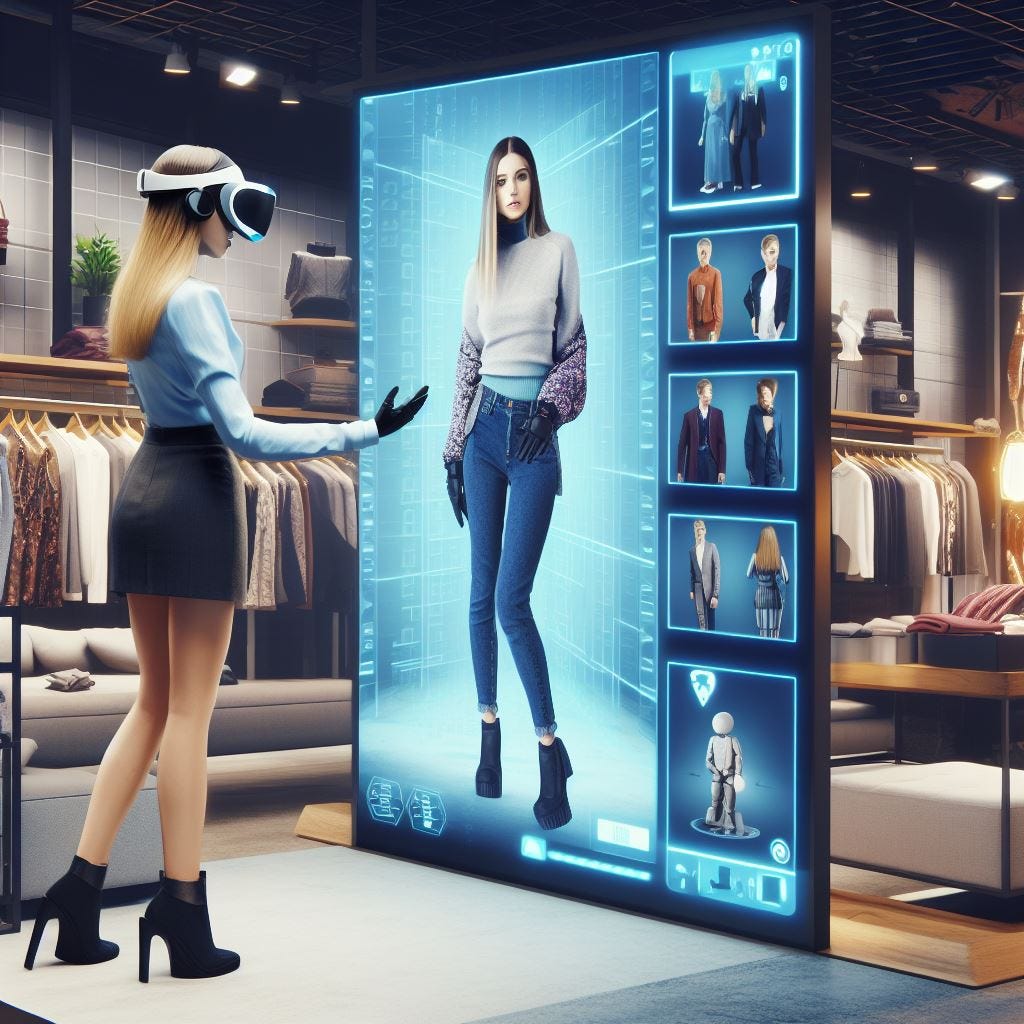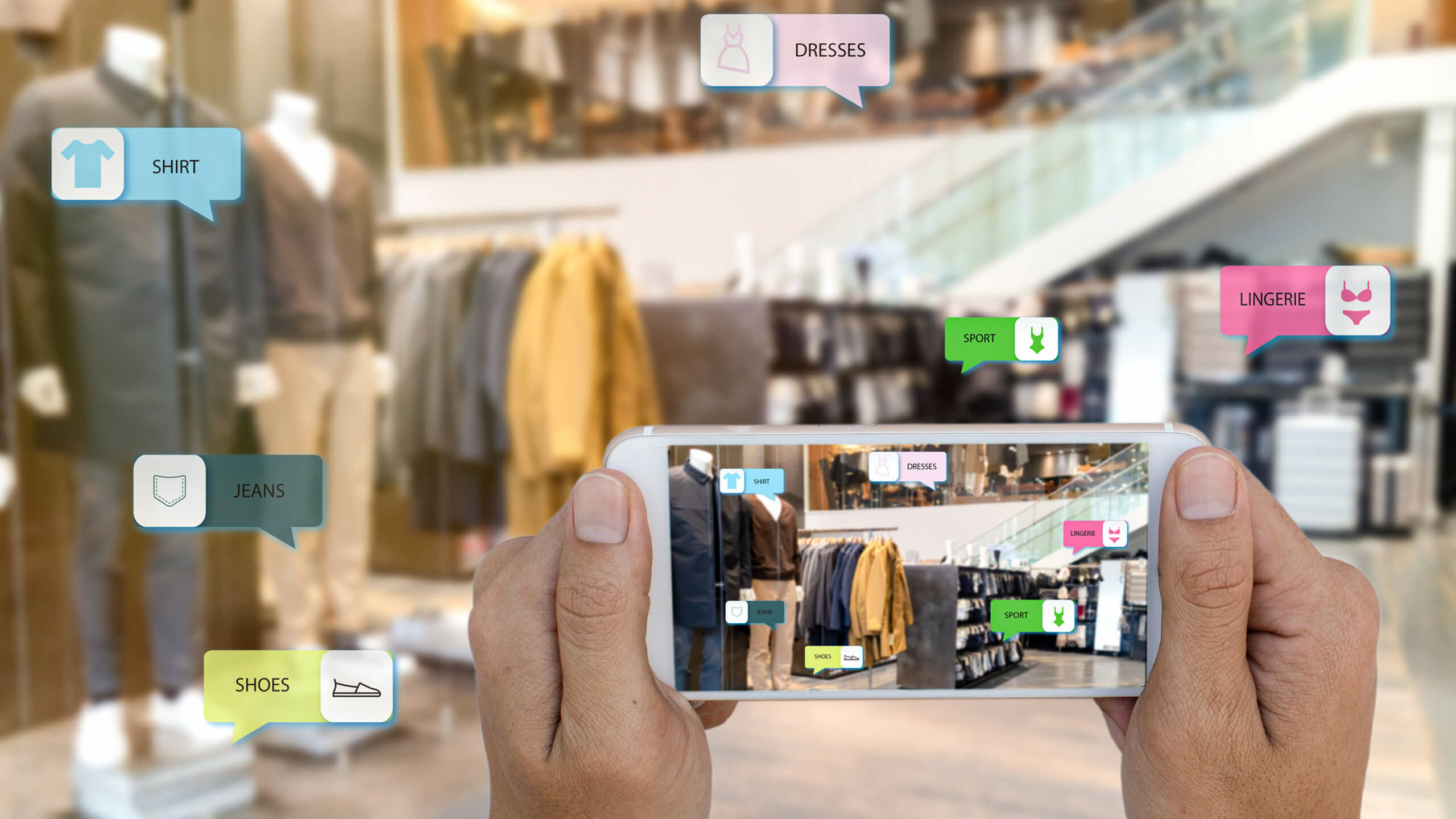Imagine shopping from anywhere with the help of AI! AR overlays furniture in your living room or lets you try on clothes virtually. VR transports you to a store replica to browse aisles and interact with products. AI personalizes the experience, recommending items and tailoring the virtual world to your tastes. This futuristic shopping is closer than ever with AR, VR, and AI.
In the rapidly evolving world of retail, businesses are constantly seeking innovative ways to captivate customers and provide truly immersive shopping journeys. Two groundbreaking technologies – augmented reality (AR) and virtual reality (VR) are at the forefront of this revolution, reshaping the retail landscape and promising to deliver unparalleled experiences. As we delve into the realm of immersive retail, it becomes evident that companies that embrace these cutting-edge technologies are poised to gain a significant competitive edge.
The Augmented Reality Revolution
The way we shop is undergoing a dramatic transformation fueled by augmented reality (AR). AR overlays digital elements onto the physical world, creating immersive experiences that are revolutionizing the shopping journey. Imagine virtually trying on clothes without stepping into a fitting room, or placing a 3D model of a couch in your living room to see if it matches the decor. AR empowers customers with these capabilities and more, fostering a more informed, engaging, and ultimately, satisfying shopping experience.
One of the most compelling use cases of AR in retail is virtual try-on experiences. Leading brands like ASOS, Sephora, and Warby Parker have already embraced this technology, allowing customers to virtually try on clothing, makeup, and eyewear before purchasing. This not only enhances the shopping experience but also reduces the likelihood of returns, as customers can make more informed decisions.
In-store AR implementations are also gaining traction, with retailers like IKEA and Lowe’s leveraging the technology to provide interactive product demonstrations and visualizations. Customers can use their smartphones to project virtual furniture into their physical surroundings, enabling them to make more informed decisions about how a piece would fit and complement their living spaces.
Virtual Reality: A Gateway to Immersive Experiences
Virtual reality (VR) takes the concept of immersive shopping a step further. Unlike AR that layers virtual elements onto reality, VR transports you entirely into a digital environment. This opens a world of possibilities for retailers to create captivating shopping experiences that transcend physical limitations.
Imagine stepping into a virtual mall and browsing stores from anywhere in the world. You could walk through a meticulously recreated furniture store, virtually placing items in your digital cart to see how they'd look in your own home. VR can also be used to virtually try on clothes, explore exotic destinations before booking a trip, or even attend personalized car showrooms to test drive dream vehicles in a safe, simulated environment.
What Augmented Reality Brings to Shopping
Augmented reality (AR) acts as a game-changer for the shopping experience by bridging the gap between the physical and digital worlds. Here's what AR brings to the table:
Virtual Try-Before-You-Buy:
Imagine trying on clothes or makeup without stepping into a fitting room. AR allows you to see how clothes would look on your body or how makeup would complement your features virtually. This reduces the hassle of changing rooms and ensures a better fit, leading to fewer returns.
Enhanced Product Visualization:
Ever struggled to picture how furniture would fit in your living room or how a new paint color would look on your walls? AR allows you to see 3D models of products placed directly in your environment, giving you a clear idea of scale and compatibility before you buy.
Interactive Product Information:
AR can transform product labels into interactive experiences. Point your phone at a product, and see detailed specifications, assembly instructions, or even customer reviews come to life right before your eyes.
Personalized Shopping Experiences:
AR can personalize your shopping journey. Imagine walking into a store and receiving product recommendations based on your preferences or past purchases, all through an AR app. This can streamline your shopping experience and help you discover new products you might be interested in.
Gamification and Engagement: AR can transform shopping into a fun and interactive experience. Imagine participating in treasure hunts within a store using an AR app, unlocking discounts or learning more about products through interactive games. This can increase engagement, especially among younger demographics.
From Apps to Virtual Stores: AR's Retail Revolution
AR has come a long way in the retail industry. It started with simple apps that allowed customers to virtually try on clothes or visualize furniture in their place. Now, with advancements in technology, AR experiences have become more sophisticated and realistic. Companies are leveraging AR to create interactive product catalogs, virtual fitting rooms, and even virtual pop-up stores.
How is AI Revolutionizing Your Augmented Reality Shopping Experience
-
Smarter Virtual Try-Ons: AI analyzes your body type and preferences to recommend the perfect size and fit for clothes you're virtually trying on. It can even suggest complementary items to complete your look.
-
Personalized Product Placement: Imagine walking into a store and seeing AR product recommendations tailored to your past purchases or browsing habits. AI takes the guesswork out of finding what you need.
-
Real-Time Style Advice: Unsure if that bold shirt complements your outfit? AI-powered AR can analyze your chosen items and offer real-time style suggestions, ensuring you look your best.
-
Context-Aware Product Information: AI understands your surroundings. Point your phone at a stain on your shirt, and AR might suggest stain removers. Need a recipe for that new pressure cooker? AI can display recipes right on your phone through the AR interface.
-
Seamless Shopping Journey: AI can track your shopping journey through an AR app. It can streamline the checkout process, recommend additional items based on your cart, and even navigate you to the right section of the store to find what you need.
Taking AR to Your E-commerce Store: Here's What to Know
integration Challenges and Solutions
-
So, you're thinking of adding AR to your e-commerce platforms? It's an exciting move, but it's not without its challenges. From the technical side, ensuring smooth integration with existing systems and platforms can be complex.
-
Moreover, creating high-quality and realistic AR experiences requires investment in both technology and content creation. However, these challenges can be overcome through partnerships with AR technology providers and leveraging AI algorithms to optimize and streamline the integration process.
Choosing the Right AR Technology for Your E-commerce Platform
-
When choosing an AR technology for your e-commerce platform, it is important to consider factors such as compatibility with existing systems, scalability, ease of use, and the level of customization offered. It is also crucial to select a technology that aligns with your business goals and target audience.
-
Conducting thorough research and testing, as well as seeking feedback from customers, can help you make an informed decision and ensure the successful implementation of AR technology in your e-commerce platform.
In essence, Augmented Reality (AR) shopping experiences powered by Artificial Intelligence (AI) offer e-commerce and online sellers a unique opportunity to enhance customer engagement, increase conversions, and provide an immersive and personalized shopping experience. By embracing AR and AI technologies, online sellers can stay ahead of the curve and pave the way for the future of e-commerce.
Overcoming Challenges in AR Shopping Implementations
While the potential of AR-powered shopping experiences is compelling, there are challenges that need to be addressed for successful implementation.
Technical Limitations and Solutions
-
The success of AR shopping experiences relies heavily on the technology behind them. Issues such as tracking accuracy, device limitations, and network connectivity can hinder the seamless integration of AR into the shopping process. However, advancements in AI algorithms, hardware capabilities, and faster networks provide solutions to many of these technical challenges. As technology continues to improve, we can expect smoother and more reliable AR shopping experiences.
User Adoption and Training
-
Introducing AR shopping experiences to customers requires proper education and user adoption strategies. Not everyone may be familiar with how to use AR features or understand their benefits. Online sellers should invest in user-friendly interfaces and provide comprehensive tutorials to guide customers through the AR shopping journey. By making the transition to AR seamless and enjoyable, retailers can ensure widespread adoption and enthusiastic participation from their customer base.
Future Trends and Potential of AR Shopping Powered by AI
As technology continues to advance, the potential of AR shopping powered by AI only continues to grow. Here are two exciting future trends to keep an eye on:
Integration with Virtual Assistants and Voice Commerce
Imagine having a virtual assistant in your AR shopping experience, guiding you through the process and providing personalized recommendations. Integration with virtual assistants and voice commerce offers a hands-free and intuitive way to interact with AR shopping experiences. With AI-powered algorithms understanding customer preferences and delivering tailored suggestions, the future of personalized shopping is bright.
Advancements in AR Wearables and Mobile Devices
-
The growing popularity of AR wearables, such as smart glasses and AR-enabled smartphones, opens up new possibilities for immersive shopping experiences. As these devices become more accessible and affordable, retailers can leverage their capabilities to offer seamless and truly hands-on AR shopping experiences. From virtual fitting rooms to enhanced product visualizations, advancements in AR wearables will undoubtedly shape the future of e-commerce.
Conclusion :
The convergence of Augmented Reality (AR), Virtual Reality (VR), and Artificial Intelligence (AI) is poised to revolutionize the way we shop. AR bridges the physical and digital worlds, allowing for virtual try-ons and enhanced product visualization. VR transports us entirely into immersive shopping experiences, transcending geographical limitations. AI acts as the intelligent engine behind it all, personalizing our shopping experience, offering real-time recommendations, and streamlining the entire journey. This powerful combination promises a future of shopping that is not only convenient and informative, but also engaging and enjoyable for both consumers and retailers. As these technologies continue to evolve, the possibilities for a truly transformative shopping experience are limitless.
Read more :
AI POWERED FRAUD DETECTION AND LOSS PREVENTION
Demand Forecasting with AI: Avoiding Stockouts and Overstocking
Predictive Maintenance for Retail Equipment: Using AI to Prevent Downtime
Optimizing Delivery Routes and Logistics with AI
For more information contact : support@mindnotix.com
Mindnotix Software Development Company


 AI-Taxi App
AI-Taxi App AI-Food App
AI-Food App AI-Property Mgmt App
AI-Property Mgmt App AI-CRM
AI-CRM AI-Fantasy App
AI-Fantasy App
 Web Development
Web Development App Development
App Development Business & Startup
Business & Startup Hire Developer
Hire Developer
 Digital Marketing
Digital Marketing Lead-generation
Lead-generation Creative Agency
Creative Agency Branding Agency
Branding Agency Augmented Reality
Augmented Reality Virtual Reality
Virtual Reality Internet of Things
Internet of Things Artificial Intelligence
Artificial Intelligence Blockchain
Blockchain Chatbot
Chatbot



